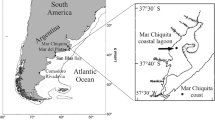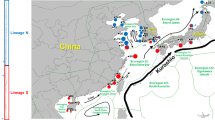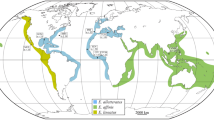Abstract
Seabob shrimps of the genus Xiphopenaeus are important fishery resources along the Atlantic and Pacific coasts of Central and South America. The genus was considered to comprise two species: the Atlantic Xiphopenaeus kroyeri (Heller, Sitzungsber Math Naturwiss cl kaiserliche Akad Wiss Wien 45:389–426, 1862), and the Pacific Xiphopenaeus riveti (Bouvier, Bull Mus Hist Nat Paris 13:113–116, 1907). In a recent review, Xiphopenaeus was regarded as a monotypic genus, on the basis that no clear morphological differences could be found between Pacific and Atlantic specimens (Pérez Farfante and Kensley, Mem Mus Nat Hist Nat Paris 175:1–79, 1997). In the present work, nuclear (allozymes), and mitochondrial (Cytochrome Oxidase I) genes were used to demonstrate the validity of X. riveti and reveal the presence of two cryptic species of Xiphopenaeus within X. kroyeri in the Atlantic Ocean. The high levels of molecular divergence among these species contrast with their high morphological resemblance. Interspecific sequence divergences (Kimura 2-parameter distance) varied from 0.106 to 0.151, whereas intraspecific distances ranged from 0 to 0.008 in Xiphopenaeus sp. 1, from 0 to 0.003 in Xiphopenaeus sp. 2, and from 0.002 to 0.005 in X. riveti. In addition, five diagnostic allozyme loci were found between sympatric samples of Xiphopenaeus sp. 1 and 2 along the Brazilian coast. The results suggest that Xiphopenaeus sp. 2 from the Atlantic is more closely related to the Pacific X. riveti than to the Atlantic Xiphopenaeus sp. 1. Furthermore, a high level of genetic structuring (Xiphopenaeus sp. 1: FST=0.026; P<0.05; Xiphopenaeus sp. 2: FST=0.055; P<0.01) was found in the Brazilian Xiphopenaeus populations, indicating the presence of different genetic stocks in both Atlantic species. These findings have important commercial implications as they show that the fisheries of the two Atlantic species must be managed separately, and that each one is comprised of different populations.





Similar content being viewed by others
References
Baldwin JD, Bass AL, Bowen BW, Clark WH (1998) Molecular phylogeny and biogeography of the marine shrimp Penaeus. Mol Phylogenet Evol 10:399–407
Belkhir K, Borsa P, Chikhi L, Raufaste N, Bonhomme F (2004) GENETIX 4.05, logiciel sous WindowsTM pour la génétique des populations. Laboratoire Génome, Populations, Interactions, CNRS UMR 5171, Université de Montpellier II, Montpellier, France
Bouvier EL (1907) Crustacés Décapodes nouveaux recueillis a Païta (Perú) par M. le Dr. Rivet. Bull Mus Hist Nat Paris 13:113–116
Brewer GJ (1970) An introduction to isozyme techniques. Academic Press, NY
Castro RH, Costa RC, Fransozo A, Mantelatto FLM (2005) Population structure of the seabob shrimp Xiphopenaeus kroyeri (Heller 1862) (Crustacea: Penaeoidea) in the littoral of São Paulo, Brazil. Sci Mar 69:105–112
Damato ME, Corach D (1994) Genetic diversity of populations of the fresh-water shrimp Macrobrachium borellii (Caridea, Palaemonidae) evaluated by RAPD analysis. J Crust Biol 16:650–655
Efron B (1981) Nonparametric estimates of standard error—the jackknife, the boostrap and other resampling methods. Biometrika 68:589–599
Fabricius JC (1798) Suplementum entomologiae systematicae. Proft and Storch, Hafniae, p 572
FAO (2005) Fishstat Plus 2.30: Universal software for fishery statistical time series. Fisheries Department, Fishery information, Data and statistics unit
Felsenstein J (1981) Evolutionary trees from DNA sequences: a maximum likelihood approach. J Mol Evol 17:368–376
Felsenstein J (1985) Confidence limits on phylogenies: an approach using the bootstrap. Evolution 39:783–791
Gusmão J, Lazoski C, Solé-Cava AM (2000) A new species of Penaeus (Crustacea: Penaeidae) revealed by allozyme and cytochrome oxidase I analyses. Mar Biol 137:435–446
Gusmão J, Solé-Cava AM (2002) Um sistema de diagnóstico molecular para a identificação de espécies comerciais de camarões marinhos brasileiros. In: Blas I (ed) CIVA 2002: Comunicaciones y Foros de Discusión. Primer Congreso Iberoamericano Virtual de Acuicultura. (http://www.civa2002.org). Zaragosa, pp 754–764
Heller C (1862) Beiträge zur näharen Kenntnis der Macruoren. Sitzungsber Math Naturwiss cl kaiserliche Akad Wiss Wien 45:389–426, plates 1–2
Hoelzel AR, Green A (1992) Analysis of population-level variation by sequencing PCR-amplified DNA. In: Hoelzel AR (eds) Molecular Genetic Analysis of Populations. Oxford University Press, Oxford, pp 159–188
Hualkasin W, Sirimontaporn P, Chotigeat W, Querci J, Phongdara A (2003) Molecular phylogenetic analysis of white prawn species and the existence of two clades in Penaeus merguiensis. J exp mar Biol Ecol 296:1–11
Kimura M (1980) A simple method for estimating evolutionary rates of base substitutions through comparative studies of nucleotide sequences. J Mol Evol 16:111–120
Knowlton N, Weigt LA (1998) New dates and new rates for divergence across the Isthmus of Panama. Proc R Soc Lond B 265:2257–2263
Knowlton N (2000) Molecular genetic analyses of species boundaries in the sea. In: Solé-Cava AM, Russo CAM, Thorpe JP (eds) Marine genetics. Kluwer, Dordrecht, pp 73–90
Kumar S, Tamura K, Jakobsen IB, Nei M (2001) MEGA2: molecular evolutionary genetics analysis software. Bioinformatics 17:1244–1245
Lavery S, Chan TY, Tam YK, Chu KH (2004) Phylogenetic relationships and evolutionary history of the shrimp genus Penaeus s.l. derived from mitochondrial DNA. Mol Phylogenet Evol 31:39–49
Lester LJ (1983) Developing a selective breeding program for penaeid shrimp mariculture. Aquaculture 33:41–50
Manchenko GP (1994) Handbook of detection of enzymes on electrophoretic gels. CRC Press Inc, MI
Marko PB (2002) Fossil calibration of molecular clocks and the divergence times of geminate species pairs separated by the Isthmus of Panama. Mol Biol Evol 19:2005–2021
McDonald JH, Kreitman M (1991) Neutral mutation hypothesis test. Nature 354:116–116
Mulley JC, Latter BDH (1980) Genetic variation and evolutionary relationships within a group of thirteen species of penaeid prawns. Evolution 34:904–916
Murphy RW, Sites JW, Buth DG, Haufler CH (1990) Proteins I. Isozyme electrophoresis. In: Hillis DM, Moritz C (eds) Molecular Systematics. Sinauer Associates, MA, pp 45–126
Nakagaki JM, Negreiros-Fransozo ML (1998) Population biology of Xiphopenaeus kroyeri (Heller 1862) (Decapoda: Penaeidae) from Ubatuba Bay, São Paulo, Brazil. J Shellfish Res 17:931–935
Nei M (1978) Estimation of average heterozygosity and genetic distance from a small number of individuals. Genetics 89:583–590
Neto JD, Dornelles LDC (1996) Diagnóstico da pesca marítima do Brasil. Coleção Meio Ambiente (Série Estudos—Pesca 20) IBAMA, Brasília
Ota T (1993) DISPAN: Genetic distance and phylogenetic analysis. Institute of Molecular Evolutionary Genetics, The Pennsylvania State University, PY
Paiva MP, Bezerra RC, Fonteles-Filho AA (1971) Tentativa de avaliação dos recursos pesqueiros do nordeste brasileiro. Arq Ciênc Mar Fortaleza 11:1–43
Palumbi SR, Benzie J (1991) Large mitochondrial DNA differences between morphologically similar penaeid shrimp. Mol Mar Biol Biotechnol 1:27–34
Pérez Farfante I, Kensley B (1997) Penaeoid and sergestoid shrimps and prawns of the world. Keys and diagnoses for the families and genera. Mem Mus Nat Hist Nat Paris 175:1–79
Posada D, Crandall K (1998) Modeltest: testing the model of DNA substitution. Bioinformatics 14:817–818
Quan J, Zhuang Z, Deng J, Dai J, Zhang YP (2004) Phylogenetic relationships of 12 Penaeoidea shrimp species deduced from mitochondrial DNA sequences. Biochem Genet 42:331–345
Rozas J, Sánchez-DelBarrio JC, Messeguer X, Rozas R (2003) DnaSP, DNA polymorphism analyses by the coalescent and other methods. Bioinformatics 19:2496–2497
Saitou N, Nei M (1987) The Neighbor-Joining method: a new method for reconstructing phylogenetic trees. Mol Biol Evol 4:406–425
Shaw CR, Prasad R (1970) Starch gel electrophoresis of enzymes—a compilation of recipes. Biochem Genet 4:297–320
Smith S (1869) Notice of the Crustacea collected by Prof. C.F. Hartt on the coast of Brazil in 1867. Trans Conn Acad Sci 2:1–42
Sneath PHA, Sokal RR (1973) Numerical taxonomy. WH Freeman, San Francisco, USA
Sunden SLF, Davis SK (1991) Evaluation of genetic variation in a domestic population of Penaeus vannamei (Boone): a comparison with three natural populations. Aquaculture 97:131–142
Swofford DL (1998) PAUP. Phylogenetic analysis using parsimony, Version 4 Sinauer, Sunderland, MA
Swofford DL, Selander RB (1981) BIOSYS-1, a FORTRAN programme for the comprehensive analysis of electrophoretic data in population genetics and systematics. J Hered 72:281–283
Tajima F (1989) Statistical method for testing the neutral mutation hypothesis by DNA polymorphism. Genetics 123:585–595
Thompson JD, Gibson TJ, Plewniak F, Jeanmougin F, Higgins DG (1997) The ClustalX Windows interface: flexible strategies for multiple sequence alignment aided by quality analysis tools. Nucleic Acid Res 25:4876–4882
Thorpe JP, Solé-Cava AM, Watts PC (2000) Exploited marine invertebrates: genetics and fisheries. Hydrobiologia 420:165–184
Voloch C, Solé-Cava AM (2005) Genetic structure of the sea-bob shrimp (Xiphopenaeus kroyeri Heller 1862; Decapoda: Penaeidae) along the Brazilian Southeastern coast. Gen Mol Biol 28:257–257
Waples RS (1987) A multispecies approach to the analysis of gene flow in marine shore fishes. Evolution 41:385–400
Ward RD, Beardmore JA (1977) Protein variation in the plaice (Pleuronectes platessa). Gen Res 30:45–62
Weir BS, Cockerham CC (1984) Estimating F-statistics for the analysis of population structure. Evolution 38:1358–1370
Acknowledgements
The authors would like to thank P. Vianna and P. Paiva for help with collecting the samples from Poças and Panama and M. Donato for the Venezuelan samples, R. Schama for help with sequence analyses, and C. Zilberberg for critical comments on the first version of the manuscript. This work was supported by grants from CAPES, CNPq, FAPERJ, FUJB and PADCT (Brazil).
Author information
Authors and Affiliations
Corresponding author
Additional information
Communicated by O. Kinne, Oldendorf/Luhe
Communicated by O. Kinne, Oldendorf/Luhe
Rights and permissions
About this article
Cite this article
Gusmão, J., Lazoski, C., Monteiro, F.A. et al. Cryptic species and population structuring of the Atlantic and Pacific seabob shrimp species, Xiphopenaeus kroyeri and Xiphopenaeus riveti . Mar Biol 149, 491–502 (2006). https://doi.org/10.1007/s00227-005-0232-x
Received:
Accepted:
Published:
Issue Date:
DOI: https://doi.org/10.1007/s00227-005-0232-x




